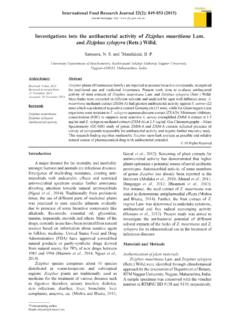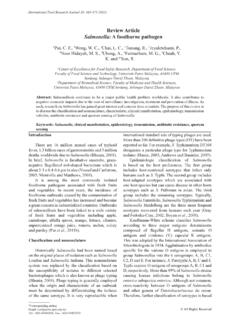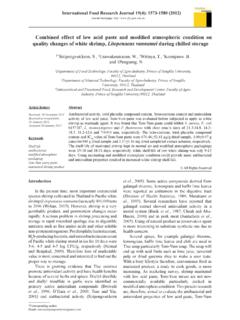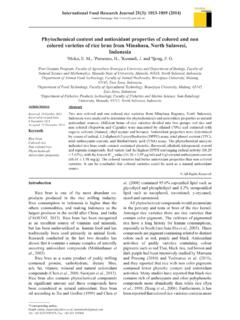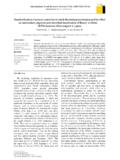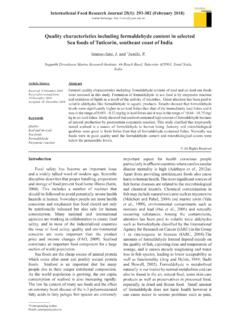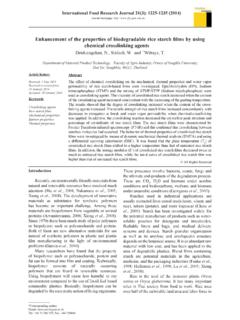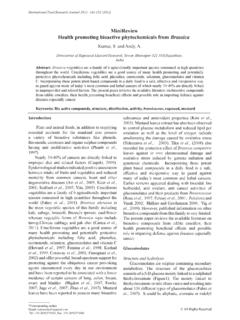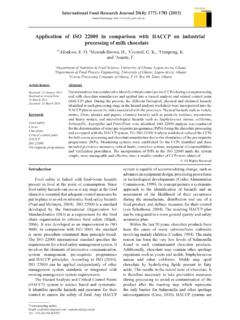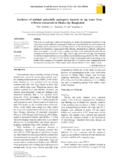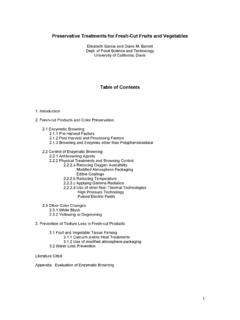Transcription of Effects of fish species on the characteristics of fish cracker
1 All Rights Reserved*Corresponding author. Email: 66-7331-3928; Fax: 66-7333-4609 International Food Research Journal 22(5): 2078-2087 (2015)Journal homepage: *Kaewmanee, T., 1 Karrila, and 2 Benjakul, of Food Science and Nutrition, Faculty of Science and Technology Prince of Songkla University, Muang, Pattani, 94000, Thailand2 Department of Food Technology, Faculty of Agro-Industry, Prince of Songkla University, Hat Yai, Songkhla, 90112, ThailandEffects of fish species on the characteristics of fish crackerAbstractFish cracker (Thai name: Khao Kieb Pla, also widely known as Keropok) is a popular snack in Thailand and other ASEAN countries.
2 The main ingredients for making fish cracker are tapioca flour, fish meat, and some seasonings. The types of fish used could affect the cracker characteristics . The aim of this research was to investigate the Effects of fish type on physical, textural, microstructure and sensory properties of cracker . The characteristics of cracker gel (CG), half-finished cracker (HFC) and puffed cracker (PC) prepared from 6 fish species , namely Thunnus tonggol, Decapterus maruadsi, Sardinella gibbosa, Trichiurus lepturus, Priacanthus tayenus, and Nemipterus hexodon, were compared.
3 The CG and PC samples varied in colour and texture. The lowest lightness (L*) and highest redness (a*), in both CG and PC, were found with T. tonggol (p< ), while the highest yellowness (b*) was obtained with D. maruadsi. The CG made with T. lepturus, P. tayenusor N. hexodon showed lower hardness, springiness and cohesiveness than with the other fish species (p< ). The pasting behaviors of HFC varied with fish species , and a high linear expansion with a low hardness of PC were obtained in samples with fishes that have a low lipid content. The PC from T.
4 Tonggol had low oil absorption while the other fishes gave absorptions similar to each other. Confocal laser scanning micrographs indicated released lipids in CG made with fatty fish. Scanning electron micrographs revealed that the lean fish gave porous puffed products, with comparatively thin-walled pores in the cracker relative to PC from fatty fish. This study demonstrated that fish type affects important characteristics of cracker . Therefore, the quality control of fish cracker will necessarily involve also control of the raw materials, and in particular screening of the fish preparing fish cracker one starts by mixing fish meat, tapioca flour, water, and some seasonings including salt, sugar, and monosodium glutamate.
5 The homogeneous mixture, typically in a cylindrical shape resembling a sausage, is gelatinized by boiling or steaming to obtain gelatinized dough. The dough is then cooled, sliced and air-dried or sun-dried to 10-12 percent moisture content (Huda et al., 2010). The dried sliced product (a half-finished product) has a comparatively good shelf-life, and is fried in cooking oil to the finished product consumed as snack food. During deep-frying in oil, within only a few seconds the cracker expands from small-sized semi-transparent chips to turbid puffy crackers, as water bound to the starch expands to steam.
6 Good quality cracker must have sufficient expansion on puffing for crispness, as well as low moisture content and low oil absorption (Karrila et al., 2011). A number of previous studies have attempted to improve the quality and acceptability of fish cracker . In order to improve fish cracker quality, the Effects of steaming time and the addition of food additives (sodium bicarbonate, sodium polyphosphate and ammonium bicarbonate) have been studied (Cheow et al., 1999; Nurul et al., 2009).Marine fish are more commonly used than freshwater fish in making cracker .
7 The commercial fish crackers in Thailand are usually produced from tuna, sardine and mackerel, though the choice of fish depends on availability, cost and the required quality of the final product (Huda et al., 2010). In the southern part of Thailand, fish used by the surimi producing industry are also used for making cracker . In general, both pelagic and demersal fish can be used in fish cracker . The pelagic fish inhabit water close to the surface or in middle depths, and generally feed on plankton.
8 The demersal fish in contrast sink close to or onto the bottom of the sea, feeding on benthic organisms. These categories of fish differ in composition, such as protein and lipid KeywordsFish speciesCrackerTextural propertyLinear expansionHardnessArticle historyReceived: 3 September 2014 Received in revised form: 23 January 2015 Accepted: 29 January 20152079 Kaewmanee et 22(5): 2078-2087contents, and the choice of category might affect the characteristics of cracker . Fish protein hydrolysate, dried surimi powder, and wash water protein from fish ball processing have also been used in fish cracker formulations (Yu et al.)
9 , 1990; Yu et al, 1994).Although many kinds of fish have been used to make cracker , there is no prior information regarding the Effects of fish type on cracker characteristics , at least not in the scientific literature. Therefore, the objective of this study was to determine the Effects of fish species on cracker characteristics , including pelagic fish, namely T. tonggol, D. maruadsi and S. gibbosa, and demersal fish, namely T. lepturus, P. tayenus and N. hexodon. Knowledge of how the choice of fish affects the quality of cracker helps make informed choices on selecting the fish raw material, or on substituting with other fish when the primary choice is not available.
10 These choices become the more important as cracker production progresses from a cottage industry towards true industrial scale. When such scale is reached, likely mixtures of fish species will need to be used, with some bounds for the blend and MethodsChemicalsNile blue A and acridine orange were procured from Sigma (St. Louis, MO, USA). Glutaraldehyde and ethanol were obtained from Merck (Darmstadt, Germany).Fish collection and preparationSamples of the pelagic fish species T. tonggol ( fish/kg), D. maruadsi (7 fish/kg), S.
